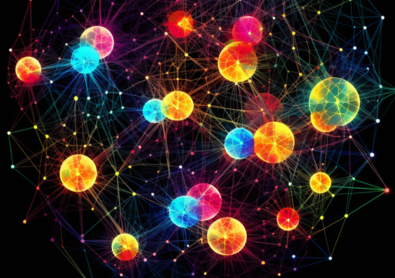Welcome to the world of deep learning algorithms, where we will delve into the intricate workings of this cutting-edge technology. By understanding the basics of deep learning, we can appreciate its potential to revolutionize our approach to complex tasks, from healthcare to transportation. So let’s explore this exciting field of artificial intelligence together—it’s changing the world as we know it!
What is deep learning?
Ever wondered how your phone recognizes your face or how Siri understands your voice commands? The answer lies in something called deep learning, a subset of machine learning inspired by the way the human brain functions. In simple terms, it is a technology that enables machines to learn, understand, and make decisions autonomously. By using neural networks and complex algorithms, deep learning analyzes large amounts of data to identify patterns in datasets. These patterns are then used to make predictions and decisions. For instance, deep learning algorithms can identify objects in images, transcribe speech into text, and even understand human language.
Applications of deep learning
The applications of deep learning are endless, spanning various fields, including healthcare, finance, transportation, and gaming. Here are a few examples of how deep learning is already being put into action:
Image recognition
Deep learning algorithms can detect faces in photos on social media platforms, identify objects in medical scans, and even recognize handwriting.
Speech recognition
Deep learning algorithms can transcribe spoken words into text. This technology is used in virtual assistants like Siri and Alexa, in voice-controlled devices like smart speakers to understand our commands, and in speech-to-text software.
Natural language processing
Deep learning algorithms are used in natural language processing to analyze and understand human language, which is essential for chatbots and other programs that require machines to understand human language and respond accordingly. For instance, in customer service, chatbots powered by deep learning can quickly and accurately answer questions and resolve issues.
Robotics
Deep learning algorithms are used in robotics to teach machines to learn from their surroundings and make decisions. This is evident in the field of self-driving cars, drones, and other autonomous systems. In manufacturing, deep learning algorithms can be used to improve the quality of products by analyzing images of them as they move through an assembly line.
Neural networks
Neural networks are algorithms that mimic the way our brains work. They consist of artificial neurons arranged in layers that communicate with each other through “synapses.” Neural networks are commonly used in applications such as image recognition, speech recognition, natural language processing, and robotics. They are really good at identifying patterns in complex data that lacks a clear structure. Therefore, neural networks are responsible for the amazing technologies we encounter on a daily basis, such as self-driving cars and voice assistants.
Training process
Training a neural network is like teaching a child how to recognize things. You show them a picture of a dog and tell them it’s a dog, and in turn, they will be able to recognize dogs on their own. The same training process applies to deep learning. By feeding it a massive amount of data and telling it what it is, the neural network learns to recognize patterns and make decisions autonomously. This process is known as supervised learning.
During the training process, the network is given a set of inputs and a set of corresponding outputs, and it adjusts its weights based on the difference between its predicted outputs and the actual outputs. After it has been trained, the network can make predictions based on new data. This process is known as inference, and it is how we use deep learning to make predictions and solve problems.
Deep learning in art
Deep learning in art opens up new horizons for creativity with AI art generators, and creating art has never been easier—or more exciting! These innovative tools leverage deep learning algorithms to generate unique and captivating artwork. From abstract art with Midjourney to personalized portraits with Parti and dreamy night sky images with StarryAI, the possibilities are endless!
As AI generators continue to evolve, we can expect even more exciting applications of deep learning in the world of art and design, shaping the world we live in. The next time you witness something awe-inspiring happening with technology, remember that deep learning is often the driving force behind it!
To learn more about how AI art generators utilize unsupervised learning, read our article on “How AI Art Generators Use Unsupervised Learning.”
Explore the distinctions between supervised and unsupervised machine learning in our article on “Supervised vs. Unsupervised Machine Learning.”
Download AppRelated Resources
10 Best AI Avatar Generators to Try
Generated via Midjourney Discover the top AI avatar generators and create your unique digital persona with ease. In our rapidly…
Read MoreAI Joins Shutterstock’s Image Library
A Brave New World of Creative Imagery Credit: Shutterstock In a world that's bursting at the seams with visuals and…
Read More6 AI Photo Editing Apps You Need to Know About
Enhance Your Photos in a Snap Generated via Midjourney Photography enthusiasts have experienced their fair share of struggles when it…
Read MoreAI Gaming: A New Era of Play
Transforming Gaming as We Know It [video width="1600" height="900" mp4="https://aiartmaster.co/wp-content/uploads/2023/10/video-game-loop-1.mp4" loop="true" autoplay="true"][/video] Video Credit: Jitao Zhou/Rikkyo University Gaming…
Read MoreReal or Fake? How to Spot an AI-Generated Image
Detecting Digital Image Forgeries In today's world, AI is advancing so rapidly that distinguishing real photos from fake ones can…
Read MoreThe 10 Top AI Trends for 2024
Generative AI Trends for 2024: Shaping a New Era As we kickstart the year 2024, it's time to prepare for…
Read MoreTraditional Art Vs Digital Art: Canvas Vs Code
In the vast realm of artistic expression, two mediums have emerged as prominent contenders: traditional art and digital art. While…
Read MoreMachine Learning Core Components
Representation: Translating Data into Meaning Data representation is the linchpin of machine learning. It's the intricate process of converting raw,…
Read More

